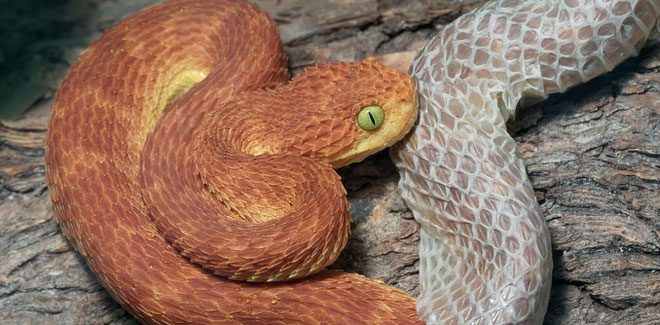To answer this question, we need to explore the “mechanism of action” and the coloration of snake skin.
In fact, all animal species shed their skin throughout their lives. This process is necessary to replace old skin, heal wounds, and allow the animal to grow in size. Most animals, including humans, continuously shed small pieces of dead skin.

A snake shedding its skin. (Image: Shutterstock).
However, snakes are different; they have to do it all at once. This is because snake skin is not like that of most other animals.
Snake skin consists of two main layers: the soft tissue layer, which is colorful (scientists refer to it as the “dermis”), and the hard scale layer, which is translucent.
The dermis is filled with nerve endings, allowing snakes to sense everything that touches them, as well as tiny particles called pigments, which provide coloration to their skin.
The scales lie over the soft dermis of the snake. This part is much tougher than the skin because it is made of “keratin,” similar to human nails and hair.
In mammals, like humans, keratin develops from a single point and continues to grow. In contrast, in snakes, keratin grows all over and is trapped on the soft dermis, protecting it like a thin shield.
While the keratin in snake and lizard scales is almost opaque, it also contains many tiny dark brown-black particles known as “melanin.” This protects snakes from harmful sunlight. This means that the scales themselves are primarily colorless or dark brown, depending on the snake species.
Sometimes, as seen in the Australian python, the outer layer of scales can shimmer with a rainbow of colors when light hits it at the right angle.
Regarding the shedding process, first, a new layer of keratin scales develops beneath the old layer. Once the new layer is fully formed, the snake rubs its body against rocks, plants, and other rough surfaces to slough off the old keratin layer, which usually comes off in a single, rough piece.
Because all the vibrant pigments are located in the soft dermis and not in the scales, the color is primarily on the snake itself rather than on the shed skin.
However, it is common for dark brown-black stripes or spots to appear on the shed skin due to the presence of melanin in the scales. Additionally, a bit of melanin pigment can sometimes make the shed skin appear black, so it is not always transparent.



















































